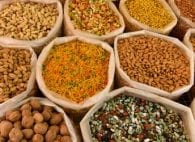An important characteristic of sugars and starches is the glycemic index (GI), which is a measure of how quickly a carbohydrate is digested, enters the bloodstream, and raises the blood-sugar level. Foods with a low glycemic index enter the bloodstream slowly and trigger the insulin response less quickly, contributing to a steadier blood-sugar level and, consequently, a steadier mood. On the other hand, foods with a high glycemic index enter the bloodstream quickly and jolt the insulin response into action, quickly leading to large blood-sugar swings — from high to low – which can cause irritability, anxiety, and jitteriness. When you eat a variety of carbohydrates together at a meal, the glycemic index is not as important. The effect of one food offsets that of another. Here’s how different kinds of carbohydrates rank from lowest to highest in glycemic index:
- legumes
- dairy products
- vegetables
- fruits
- whole grains
- refined sugars and grains
The glycemic index is more important when eating carbohydrates alone as snacks. For example, an apple, because of its lower GI, is more blood-sugar-friendly than a banana. It would be better to eat the banana, which has a higher GI, with yogurt for breakfast or with peanut butter for lunch. The foods with a lower GI will slow the absorption of the sugar in the banana.
Fat and fiber slow sugar absorption, so the sugar in ice cream would enter the bloodstream more slowly than the sugar in soda. The sugar from a baked potato eaten without sour cream gets in the bloodstream faster than one loaded with sour cream or butter. Because of the fiber, the sugar in a whole orange would enter the bloodstream more slowly than the sugar in orange juice. (Orange juice is often used as a quick perk-up for diabetics suffering a sudden bout of low blood sugar). Fiber also explains why apples have a lower glycemic index than bananas.
Sugary soft drinks will have a more uncomfortable effect on the blood sugar if they are consumed on an empty stomach than if taken with a meal. Anything that breaks down food into finer particles makes the sugar more quickly digestible, so cooking vegetables and mashing potatoes raises the glycemic index.
NUTRITIP: Sweets on a Full Stomach
Downing a 12-ounce can of sugary soda on an empty stomach is more likely to trigger the insulin roller coaster and adrenaline rush than drinking that soda with a meal. Save sweets for after- meal treats. A high-sugar breakfast is another roller-coaster starter. It sets up the working adult or the school-age child for a mid-morning hypoglycemic crash.
The glycemic index may seem like an obscure concept, important only to food chemists, but it actually affects everyone’s general health and well-being. For example, one study found that persons who tend to eat diets that are low in fiber and high in carbohydrates with a high glycemic index double their risk of diabetes, especially persons already predisposed to it. In this study, the foods that posed the greatest risk were white bread, white rice, potatoes, sugar, and soft drinks. People with the lowest incidence of diabetes had diets containing lots of whole grains, fiber-rich cereals, and other carbohydrates with a low glycemic index. It seems that high glycemic, carbohydrate-rich foods put pressure on the pancreas to produce more insulin, causing the pancreas to eventually wear out. The inability to produce enough insulin results in diabetes.
BLOATING SUGARS
Some fruits contain the sugar sorbitol, which if consumed in excess can cause gas, bloating, and diarrhea. The fruit highest in sorbitol is the prune (thus the laxative effect), followed by pears, then cherries. Peaches and apples contain a tiny bit of sorbitol. Some candies are sweetened with sorbitol. Citrus fruits contain no sorbitol.
GLYCEMIC INDEX RATINGS (lowest to highest)
- soybeans (15)
- fructose (20)
- cherries (23)
- grapefruit (26)
- kidney beans (29)
- lentils (29)
- milk (34)
- yogurt (36)
- chickpeas (36)
- apples (39)
- spaghetti (42)
- grapes (45)
- oranges (46)
- sweet potatoes (48)
- All-Bran (51)
- oatmeal (54)
- corn (59)
- table sugar (sucrose) (59)
- bananas (62)
- raisins (64)
- soft drinks (68)
- bread, white (69)
- potatoes (70)
- candy bar (70)
- bread, whole wheat (72)
- white rice (72)
- refined cereals (80)
- honey (87)
- carrots (92)
- glucose (100)
The glycemic index is the relative rate of blood sugar rising when a given food is compared with glucose, which has a glycemic index of 100. While the G.I. provides some useful information, you should take these sugar ratings with a grain of salt. Many of these numbers were based on studies of only five or six middle aged persons, and there are wide individual variations in the glycemic indexes. Also, these values were based upon eating the carbohydrate alone, yet consuming carbohydrates along with other foods (especially those high in fiber) could change the rate of absorption of the sugar. So, as with many nutritional concepts, let your body be your guide. How you feel and act following a high-carb meal is more important than someone else’s numbers. This would be your personal glycemic index.

